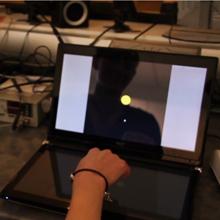30 March 2015

A video game-like tool developed from the touchscreen thinking and moving task used in the current study may be the next step in helping to improve communication between brain regions.
TORONTO – In their latest brain imaging study on women at risk for Alzheimer’s disease, York University researchers have found deterioration in the pathways that serve to communicate signals between different brain regions needed for performing everyday activities such as driving a car or using a computer.
“We observed a relationship between the levels of deterioration in the brain wiring and their performance on our task that required simultaneous thinking and moving; what we see here is a result of communication failure,” explains Professor Lauren Sergio in the School of Kinesiology & Health Science.
In an interview, Sergio in whose lab the study was conducted, says the findings also suggest that their computerized, easily-administered task that the study participants performed, can be used to test those at risk for Alzheimer’s disease to flag early warning signs. “The test is a clinically feasible substitute to the more involved braining imaging tasks that people don’t, or can’t, have done routinely.”
Typically, Alzheimer’s disease is associated with memory loss, perception and other aspects of cognition, while debility in complex movements is observed at a much later stage.
The study, Diffusion Tensor Imaging Correlates of Cognitive-Motor Decline in Normal Aging and Increased Alzheimer’s Disease Risk, recently published in the Journal of Alzheimer’s Disease, was conducted on 30 female participants of whom 10 were in their mid-20s. The rest were in their 50s or older, with half of them at high risk for Alzheimer’s disease.
“We decided to focus this study on women, as there is higher prevalence in this group, and also women who carry the ApoE4 gene are more vulnerable to the degradation of white matter,” notes PhD candidate Kara Hawkins who led the study, adding that the genetic risk factor for Alzheimer’s disease was one of the traits tested for in the current study.
“We scanned the brains of the participants, aiming to see if the impaired cognitive-motor performance in the high risk group was related to brain alterations over and above standard aging changes,” Hawkins adds.
According to the researchers, the big question ahead is ‘what can be done to prevent a decline in function of a person’s brain showing signs of communication problems?’ And the answer they are exploring is in finding ways to use these thinking and moving tasks in a proactive way, as part of a game-like cognitive-motor integration training method.
York University is helping to shape the global thinkers and thinking that will define tomorrow. York U’s unwavering commitment to excellence reflects a rich diversity of perspectives and a strong sense of social responsibility that sets us apart. A York U degree empowers graduates to thrive in the world and achieve their life goals through a rigorous academic foundation balanced by real-world experiential education. As a globally recognized research centre. York U is fully engaged in the critical discussions that lead to innovative solutions to the most pressing local and global social challenges. York U’s 11 faculties and 25 research centres are thinking bigger, broader and more globally, partnering with 280 leading universities worldwide. York U’s community is strong − 55,000 students, 7,000 faculty and staff, and more than 275,000 alumni.
Media Contact: Gloria Suhasini, York University Media Relations, 416 736 2100 ext. 22094, suhasini@yorku.ca







